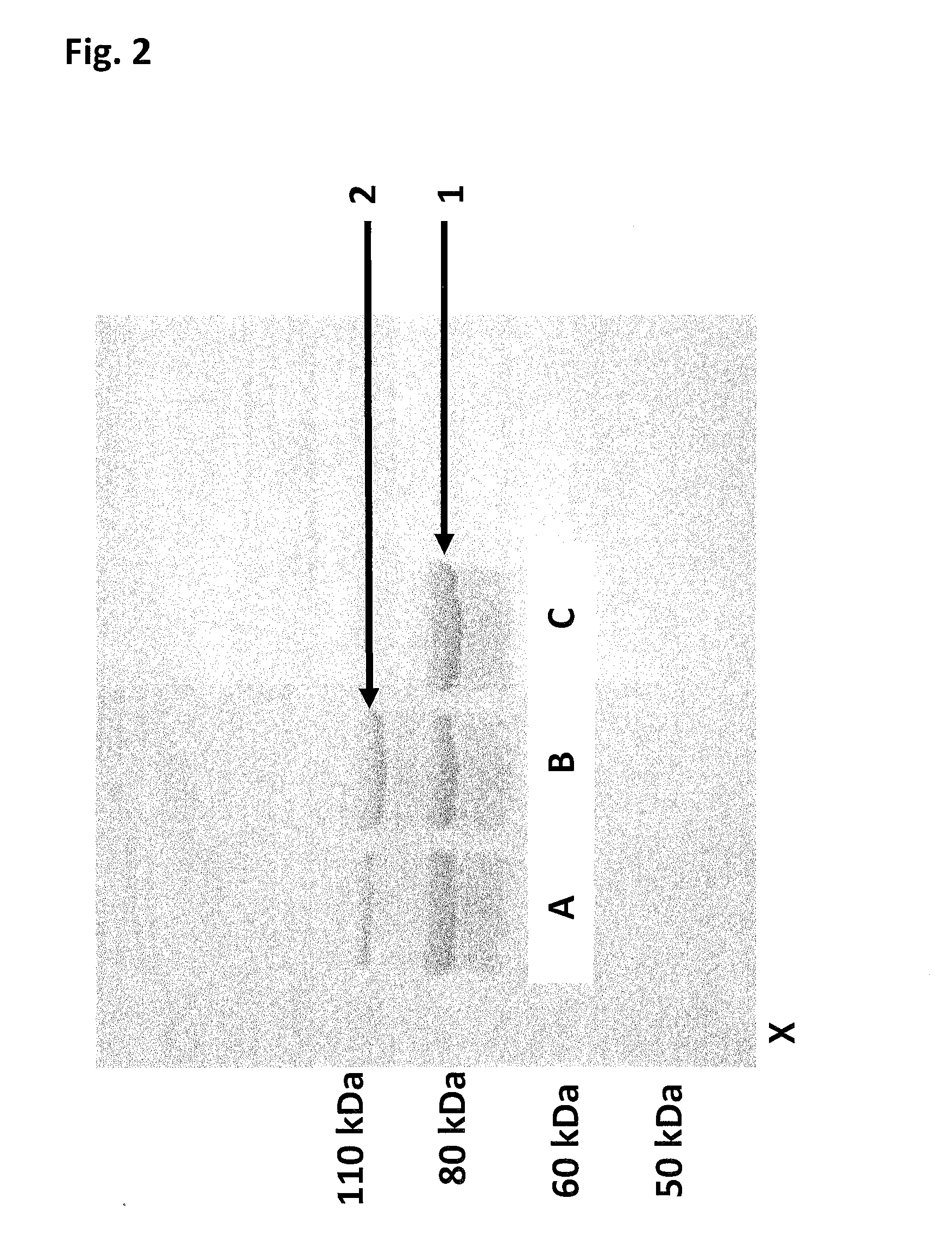Modified helicases
a technology of helicases and helicases, which is applied in the field of modified helicases, to achieve the effects of reducing the size of the opening, improving the ability of helicases and improving the ability to control the movement of polynucleotides
- Summary
- Abstract
- Description
- Claims
- Application Information
AI Technical Summary
Benefits of technology
Problems solved by technology
Method used
Image
Examples
example 1
[0471]This Example describes the method of synthesising the Hel308 Mbu (E284C / S615C)-bismaleimidePEG3 (SEQ ID NO: 10 with the mutations E284C / S615C connected by a bismaleimidePEG3 linker). In this case a covalent link between cysteines at positions 284 and 615 in the primary sequence of Hel308 Mbu (SEQ ID NO: 10) was made by reacting these positions with a bismaleimidePEG3 linker (approximately 3.7 nm in length).
[0472]In detail, 6 μl of 1 M DTT was added to 600 μL of Hel308 Mbu(E284C / S615C) (SEQ ID NO: 10 with the mutations E284C / S615C, stored in 50 mM Tris-HCl pH 8.0, 421 mM NaCl, 10% Glycerol, 10 mM DTT) and the mixture was incubated at room temperature on a 10″ wheel rotating at 20 rpm for 30 minutes. This mixture was buffer exchanged through Pierce 2 mL Zeba desalting columns, 7k MWCO into 100 mM potassium phosphate, 500 mM NaCl, 5 mM EDTA, 0.1% Tween-20 pH 8.0 to give 550 μL of sample. To this was added, 5.5 μL of bismaleimidePEG3 (QuantaBiodesign, Product Ref=10215) and the mi...
example 2
[0473]This example describes the method of synthesising the Hel308 Mbu (E284C / S615C)-mal-pep-mal (SEQ ID NO: 10 with the mutations E284C / S615C connected by a bismaleimide peptide linker (maleimide-propyl-SRDFWRS-(1,2-diaminoethane)-propyl-maleimide, SEQ ID NO: 109 corresponds to the peptide sequence SRDFWRS)). In this case a covalent link between cysteines at positions 284 and 615 in the primary sequence of Hel308 Mbu (SEQ ID NO: 10) was made by reacting these positions with a bismaleimide peptide linker (maleimide-propyl-SRDFWRS-(1,2-diaminoethane)-propyl-maleimide, SEQ ID NO: 109 corresponds to the peptide sequence SRDFWRS).
[0474]In detail, 2 μl of 1 M DTT was added to 200 μL of Hel308 Mbu(E284C / S615C) (SEQ ID NO: 10 with the mutations E284C / S615C, stored in 50 mM Tris-HCl pH 8.0, 421 mM NaCl, 10% Glycerol, 10 mM DTT) and the mixture was incubated at room temperature on a 10″ wheel rotating at 20 rpm for 30 minutes. This mixture was buffer exchanged through Pierce 2 mL Zeba desalt...
example 3
[0476]This example compares the enzyme processivity of two Hel308 Mbu helicases in which the opening has been closed (Hel308 Mbu(E284C / S615C)-bismaleimidePEG11 (SEQ ID NO: 10 with mutations E284C / S615C connected by a bismaleimidePEG11) and Hel308 Mbu(E284C / S615C)-bismaleimidePEG3) (SEQ ID NO: 10 with the mutations E284C / S615C connected by a bismaleimidePEG3 linker) to that of the Hel308 Mbu monomer (SEQ ID NO: 10) using a fluorescence based assay.
Materials and Methods
[0477]SEQ ID NOs: 110 to 114. SEQ ID NO: 112 has a carboxyfluorescein at the 5′ end and a black-hole quencher at the 3′ end.
[0478]A custom fluorescent substrate was used to assay the ability of the helicase to displace hybridised dsDNA (FIG. 3). The fluorescent substrate (50 nM final) has a 3′ ssDNA overhang, and 80 and 33 base-pair sections of hybridised dsDNA (FIG. 3 section A, SEQ ID NO: 110). The major lower “template” strand is hybridised to an 80 nt “blocker” strand (SEQ ID NO: 111), adjacent to its 3′ overhang, a...
PUM
| Property | Measurement | Unit |
|---|---|---|
| Fraction | aaaaa | aaaaa |
| Conformational barrier | aaaaa | aaaaa |
| Amphiphilic | aaaaa | aaaaa |
Abstract
Description
Claims
Application Information
 Login to View More
Login to View More - R&D
- Intellectual Property
- Life Sciences
- Materials
- Tech Scout
- Unparalleled Data Quality
- Higher Quality Content
- 60% Fewer Hallucinations
Browse by: Latest US Patents, China's latest patents, Technical Efficacy Thesaurus, Application Domain, Technology Topic, Popular Technical Reports.
© 2025 PatSnap. All rights reserved.Legal|Privacy policy|Modern Slavery Act Transparency Statement|Sitemap|About US| Contact US: help@patsnap.com



